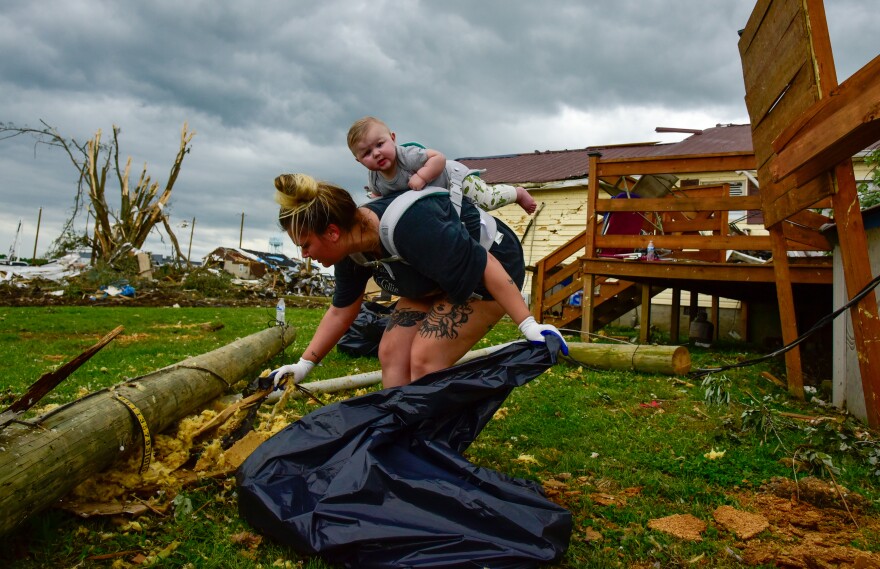Kentucky Public Radio’s Justin Hicks has been reporting on the tornadoes from London, Kentucky this week. On Tuesday, he sat down with managing editor Ryan Van Velzer to debrief on what he saw and what we know about the disaster so far.
Van Velzer: In the days since the storms, the National Weather Service has said there were about a half dozen tornadoes all around Kentucky, a lot of them in pretty rural areas. So far, they're saying they ranged anywhere from EF ones to EF threes, which have winds up to 165 miles per hour. And tentatively, they say that's what passed through Somerset and London, you got out to London on Sunday afternoon, where tornado hit a very populated area. Where did you go first?
Hicks: So I first went to this mobile home park. It's right next to the London-Corbin airport, and it got hit really hard. That whole area did. The owner of that trailer park told me there was roughly four dozen homes in just the spot that she owned, and nearly all of them sustained some kind of damage. I met Monroe Murphy there he was in one of those heavily damaged homes, and he says he was picked up into the air. His house turned upside down, and then he was thrown to the ground.
Monroe Murphy: I ended up over there in a pile of debris, hanging on to some type of wood. I don't know what it was, but it was lifting my body up, trying to suck me away. And I just hung on and hung on and hung on.

Hicks: Murphy said that force literally ripped the clothes off his body, and seconds later, when it passed, he heard just people screaming and houses all around the neighborhood.
Van Velzer: Wow, that's that's an incredible story. Do you know, did do people in London have basements in their homes?
Hicks: I don't think very many, some do, but it did not seem to be the norm. You know, of course, mobile homes don't have basements. There was a lot of that out there, and a lot of the other homes that I saw were built on concrete slab. We'll have to do some more reporting, but I wonder if that contributes to the higher death count in that yeah, possibly. I heard a lot of stories about closets and bathrooms. Not a lot of people saying they were in basements.
Van Velzer: I've seen some of your photos, and you can really see the path of destruction that the tornado took. But it also sounds like there are a lot of folks out there on Monday, helping people recover. You have this exceptional photo that you took of a woman with a baby on her back, helping her neighbors sift through their belongings.

Hicks: She was just a neighbor, a neighbor who was coming out with her family, and they were just going around and picking things up.
Van Velzer: Who else did you talk to?
Hicks: There was church groups out there. I talked to them. I saw teachers helping out. I mean, there was youth football groups. They just grabbed gloves and helped. I spoke to Hope Hoskins. She was an elementary school teacher out there, and she had a couple other teachers with her, and they really just brought some good, positive energy.
Hope Hoskins: That's the thing about these hillbilly folks. They'll come together when they need to. That's the truth. I mean, they will. There's, I mean, there's nothing like eastern Kentucky people. There really isn't.
Hicks: So it's really all hands on deck, no matter of a skill level. And people will need volunteers for weeks and months to come. So if you can't get out there right now and help out, and you're really feeling that yearning to it's okay, there will be plenty of opportunities, I'm sure. Just kind of stay tuned.

Van Velzer: While people are trying to pick up the pieces themselves. We've also heard that Kentucky has applied for assistance from the federal government. People from those agencies, FEMA, in particular, the Federal Emergency Management Agency, would be out there too. Did you see anybody from FEMA?
Hicks: I did. I was in a neighborhood Monday afternoon, and I ran into some field workers from FEMA, another from SBA. That's the Small Business Administration. So FEMA grants disaster assistance to survivors, and SBA has their own process that gives low interest loans to people. They both told me they were in the process of doing damage assessments. All those reports and data help them make decisions of whether to open up certain disaster aid programs to survivors. So they are out there. They are on the ground. It may be hard to see them, though, because there's just a few of them at the moment.
Van Velzer: Thank you so much for your reporting Justin.
Hicks: Yeah, of course. Thanks, Ryan.




